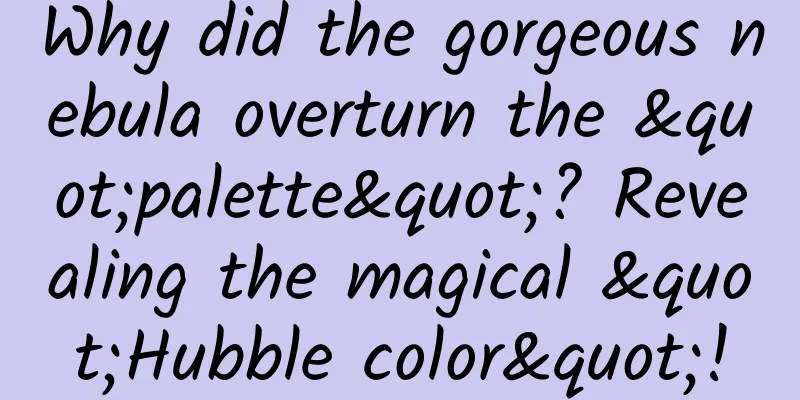Why did the gorgeous nebula overturn the "palette"? Revealing the magical "Hubble color"!

|
Author | Zhou Yihao Audit | Huang Jian Editor | Wang Qiyuan The Carina Nebula, a composite of images taken by the Hubble Space Telescope and the Blanco Telescope (Image courtesy of NASA) I believe that when you see the above picture for the first time, you will be shocked by the blend of soft and warm orange and cold green. It is like an overturned color palette, magnificent and mysterious, making you feel as if you are in a starship in "Star Trek". Bayer filter in a color camera (Image from Wikipedia) So how did this gorgeous image come about? To answer this question, let's first follow Xiaoxing to learn about the principle of digital cameras taking color photos. The camera's sensor can only sense the intensity of light, just like drawing only black and white outlines, but the color camera's sensor is covered with a layer of small filters, each of which only allows red, green or blue light to pass through. In this way, each pixel only records the brightness information of one color. After that, the camera will use a unique algorithm, just like "filling in" a black and white painting, to deduce the complete red (R), green (G), and blue (B) information of each pixel based on the colors of the neighboring pixels, and combine them to generate a color picture. The Wide Field Camera WFPC2 on the Hubble Space Telescope (Image courtesy of NASM) The Hubble Space Telescope is different. The wide-field cameras WFPC2 and WFC3 on board can collect light signals of different wavelengths with different filters. These wavelengths include visible light visible to the human eye, as well as ultraviolet and infrared light that the human eye cannot perceive. Each time it takes a picture, the Hubble Space Telescope selects a specific filter to isolate a certain wavelength of light, such as the spectral line emitted by hydrogen atoms (Hα line) or the spectral line emitted by oxygen atoms (OIII line). In this way, each image captured by the camera is actually a grayscale photo of a specific wavelength, recording the intensity distribution of light at that wavelength. This "monochrome" photo allows scientists to more accurately study the physical properties of different celestial bodies, such as stellar temperature, gas composition, and dust distribution. Color synthesis of the Bubble Nebula photo (Image courtesy of NASA) The raw data from the Hubble Space Telescope is grayscale, and to create color images, it is processed through a technique called false color. Specifically, different wavelengths of image data are assigned specific colors, such as red for infrared, blue for ultraviolet, and green for certain visible wavelengths. These "colored" layers are then stacked to create a color image that is rich in information. Although these false colors are not the true colors of celestial objects, they can help identify key features. For example, in the above Hubble Space Telescope image of the Bubble Nebula, red corresponds to nitrogen, blue to oxygen, and green to hydrogen. The Spider Nebula photographed using the SHO filter (Photo: Zhou Yihao) The Hubble palette in astronomical photography usually refers to the pseudo-color images synthesized by the SHO narrow-band filter. The three filters of sulfur (SII, wavelength 672.4 nanometers), hydrogen (Hα, wavelength 656.28 nanometers) and oxygen (OIII, wavelength 500.7 nanometers) are used to take monochrome pictures, and then they are given red, green and blue channels to synthesize colorful nebula images. Because the synthesized images are similar to the colors of the Hubble Space Telescope narrow-band photos, they are named "Hubble Palette". Comparison of the SHO color (left) and RGB color (right) of the Christmas Tree Nebula (Photo: Zhou Yihao) The use of color here is not just for "looking good", but also to highlight the originally dim or difficult to distinguish details, and allow us to transcend the limitations of the band and see the rich and colorful colors in the depths of the universe. When seeing these color-enhanced images, everyone can feel more layers and mystery behind the "sea of stars", inspiring a stronger desire for exploration and imagination. In contrast, if we only rely on images that are consistent with the colors visible to our naked eyes, although they are closer to the world we can capture, they often lack the presentation of dark structures or special energy radiation. We may only see a bright or dark cloud, but ignore the infrared or ultraviolet details that contain information. The emergence of Hubble colors perfectly combines astronomical exploration with artistic aesthetics, making scientific research vivid and tangible, and bringing the wonders of the universe into the public eye. Through these colorful and detailed images, people can intuitively appreciate the multi-layered structure of nebulae, the interactions between galaxies, and the vastness and complexity of the deep universe. The curiosity and amazement brought about by these visual impacts are precisely the most moving power of popular science. References [1] Duan Ran. The mystery of the colors of Hubble photos[J]. Astronomy Enthusiasts, 2021, (08): 50-53. [2] Li Zhengying, Wei Yong, Wang Yuqi. Hubble Space Telescope's cosmic search[J]. Modern Physics Knowledge, 2022, 34(02): 17-23. [3] Mu Zi. The 30-year-old Hubble Space Telescope[J]. Invention and Innovation (Middle School Students), 2020, (08): 9-11. [4] Hubble’s 25-year glorious journey[J]. World Science, 2015, (05): 2. [5]Whitwam ,Ryan . The Hubble Space Telescope turns 25 - here are the best 25 images [J]. ExtremeTech.com, 2015, [6] Hubble Starry Sky[J]. UFO Exploration, 2012, (03): 64. [7]Universe exploration with visible light telescopes[J]. Space Exploration, 2005, (03): 14-15. [8] The photos of the nebula are so beautiful! Are these colors real?, Beijing Planetarium, https://www.bjp.org.cn/twwd/wyjytwsy/4028c1367a595bb8017a5bec0c97000a.shtml. [9] The Meaning of Light and Color, HubbleSite, https://hubblesite.org/contents/articles/the-meaning-of-light-and-color [10] Molly Wakeling. How to take Hubble-like photos: Filters and post-processing guide, https://www.astronomy.com/observing/observing-basics-image-like-hubble/ [11] Mamenchisaurus keeper, why is the nebula I see black and white, but the one they photoshopped is in color?, WeChat public account "Guoker", https://mp.weixin.qq.com/s/R8Y3fnt5ucxnJat3XUQomg For more questions about Hubble color, please leave a message in the comment area, Xiaoxing will answer them for you one by one~ Follow the WeChat public account/Sina Weibo/Science Popularization China "Xingming Observatory" and walk through the stars with Xiaoxing to harvest romance~ |
Recommend
Is it a good thing to not gain weight? Let us help you understand the truth about obesity
Obesity may affect your good looks Or cause unexp...
The coldest weather in history meets the hottest weather in history - A brief discussion on the extreme abnormality of the weather during this year's National Day holiday
1. The meaning of extreme and abnormal In order t...
Promotion strategy of Sina Weibo Fanstong
Someone told me that Sina Weibo’s scale is not up...
Who is affected by the State Administration of Radio, Film and Television’s push for TVOS?
The State Administration of Radio, Film and Telev...
World Resources Institute: Accelerating Climate Resilient Infrastructure
The report released by the Intergovernmental Pane...
Get APP product analysis
Before fully understanding this app, everyone tho...
What is the difference between a 20 yuan shampoo and a 200 yuan shampoo?
People often complain: Why do I spend money on a ...
Xiaohongshu operation and promotion: user operation model and monetization!
I went to Hong Kong during the May Day holiday. I...
How much does it cost to outsource WeChat mini programs? What does the price of outsourcing WeChat Mini Program development include?
How much does it cost to outsource WeChat mini pr...
Xiaomi Content Report Card
Xiaomi has three core businesses: smartphones, sm...
What is NFC in your phone? Learn these tips and improve your life efficiency by 50%
Nowadays, many mobile phones have many functions,...
How to apply for a WeChat Mini Program account? How does a company register and develop a mini program?
Q: How to apply for a WeChat Mini Program account...
Millions of IPs create science and technology talents to strengthen the country丨China's aerospace industry lights up the road to exploring the universe
Exploring the mysteries of the universe has been ...
How to organize offline activities for learning communities? We offer such a solution
With the rise of knowledge payment , a large numb...
The copyright cost is 6,000 times that of "Wulin Waijia". iQiyi, Youku and Tencent Video have burned through hundreds of billions but are still not profitable. What should they do with long videos?
Domestic long video platforms represented by iQiy...









